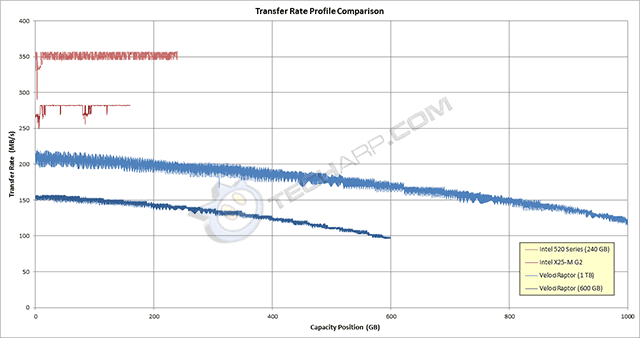Testing The HDDs And SSDs
The Testbed
Processors |
||
Motherboard |
||
Memory |
Two Kingmax 2 GB DDR3-1333 modules |
|
Graphics Card |
||
Hard Drives |
1 TB Western Digital VelociRaptor |
|
Operating System |
Microsoft Windows 7 64-bit |
Testing Methodology
We tested in both Windows 7 and Windows Vista, with the latest updates. We chose to use IO Meter 1.1.0 RC1 as well as our "old faithful", WinBench 99 2.0, with the following tests :
- Platter Data Transfer Profile
- Business Disk WinMark 99
- High-End Disk WinMark 99
- Disk Transfer Rate (Beginning)
- Disk Transfer Rate (End)
Business Disk WinMark 99 is a real-world simulation based on three office application suites - Microsoft Office 97, Lotus SmartSuite and Corel WordPerfect Suite 8, as well as a web browser, Netscape Navigator. They are quite dated, but should still reflect the usage patterns of users in an office environment using such applications. The test runs through a script that keeps multiple applications open, while it performs tasks that switches between those applications and Netscape Navigator. The result is the average transfer rate during the script run.
High-End Disk WinMark 99 is a real-world simulation based on AVS/Express 3.4, FrontPage 98, MicroStation SE, Photoshop 4.0, Premiere 4.2, Sound Forge 4.0 and Visual C++ 5.0. However, it differs by running the applications serially, instead of simultaneously. There are individual results for each application but in this comparison, we will be looking only at the weighted average score, which is the average transfer rate during the tests.
Unfortunately, WinBench 99 seemed to have some issues with Windows Vista, or the current Vista driver for the SATA controller. It would register a SetFilePointer error in the Disk Access Time test. So, we were not able to obtain any Disk Access Time results.
In addition, it would keep crashing if the hard drive was tested with a single partition. This is likely due to a limit on the size of the partition that is supported by WinBench 99. We came up with a workaround by dividing the hard drive into 2 partitions of similar sizes. We tested each partition individually and averaged the results.
The IO Meter 1.1.0 RC1 tests were carried out with the alignment set at 4 KB for the SSDs, and 512 bytes for the HDDs. In addition, we tested each SSD with repetitive (compressible) and random (non-compressible) data, and used the average of the two results. This will give us a more accurate representation of how the SSD will perform in real life.
Maximum Surface Temperature
We monitored the surface temperature of hard disk drives and solid state drives during their benchmarks. The following chart shows their operating temperature range, from idle to maximum load. Please note that instead of giving you the absolute numbers, we are showing the temperature delta, which is the difference between the actual temperature and the ambient room temperature.

Without a doubt, the solid state drives run cooler than the VelociRaptors. After all, they are solid state devices with no platters to spin, and certainly no motors. Still, it is interesting to note that the case temperature of the VelociRaptors are not very much higher than those of the Intel solid state drives.
Data Transfer Profile
Unlike hard disk drives, solid state drives do not have different areal densities. Hence, a virtually flat transfer rate profile across the entire capacity. The 240 GB Intel 520 Series SSD delivered a read throughput of around 350 MB/s, while the 160 GB Intel X25-M G2 SSD managed a transfer rate of about 280 MB/s.
At their outermost tracks, the new 1 TB VelociRaptor delivered a read throughput of about 220 MB/s, while the 600 GB VelociRaptor was just over 150 MB/s. This makes them 37% and 57% slower than the Intel 520 Series SSD, and just over 21% and 46% slower than the older Intel X25-M G2 SSD.
HDDs get slower as you will up the drive and move to the inner tracks. However, SSDs also slow down as you fill up the drive, because it reduces the number of free blocks available for quick writes. So based on these raw transfer rates, we cannot comment on how they would compare in performance if you fill up both HDDs and SSDs with data.
Support Tech ARP!
If you like our work, you can help support out work by visiting our sponsors, participate in the Tech ARP Forums, or even donate to our fund. Any help you can render is greatly appreciated!
Page |
Topic |
|
1 |
• VelociRaptors Vs. Solid State Drives |
|
2 |
• Testing The HDDs & SSDs |
|
3 |
||
4 |
||
5 |
||
6 |
||
7 |
||
8 |
||
9 |
<<< Introduction, WD VelociRaptors, Intel SSDs : Previous Page | Next Page : WinBench 99 Test Results, Transfer Rate Range >>>







 Add to Reddit
Add to Reddit

